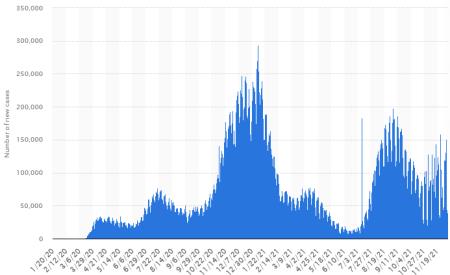|
It is emerging that the Omicron variant has a rate of infection approximately three times higher than the Delta variant. South African epidemiologists have recorded a relatively high rate of reinfection among individuals who were previously diagnosed with either the Beta or Delta variants. Emerging evidence suggests that the Omicron variant is less pathogenic than the Delta variant based on subjective clinical evaluation and the number of hospital admissions. It is noted that the proportion of the population protected by vaccination in the U.S. exceeds that in the Republic of South Africa. There are also obvious differences between South Africa and the U.S. with regard to the standard of healthcare, prevalence of immunosuppression due to HIV and the realities of suboptimal nutrition and housing.
The emergence of the Omicron variant is a cause for concern among those responsible for public health in industrialized nations, especially since there are many unknowns concerning infectivity and pathogenicity. This said, the Delta variant is the significant current challenge facing the U.S. The Delta variant is responsible for a three percent increase in infections to 660,000 over the seven-day period ending December 3rd. To date the U.S. has experienced 49 million diagnosed cases with 806,000 fatalities corresponding to a two percent death rate among those infected. On December 3rd there were 57,000 patients hospitalized with COVID, an increase of 15 percent from the previous two-week period. Concurrently fatalities attained 6,500 representing an eight percent decrease over the previous week. Hospital admissions are overwhelmingly in non-vaccinated patients confirming the protective value of the three vaccines approved by the FDA and deployed since early 2021. The U.S. has administered vaccines to 234 million U.S. residents. To date 71 percent have received at least one dose and 198 million have received two doses of an mRNA vaccine or a combination of a single-dose vaccine and an mRNA product. As at the beginning of December, 43 million had received a booster dose, but 120 million have yet to receive a third vaccination.
With regard to the Omicron and future emerging variants, international air-travel bans and other restrictions are ineffective as has been demonstrated with each sequential emerging variant. It is anticipated that bans on air-travel to and from nations in Africa will be relaxed in coming weeks. Health authorities will however require rapid tests to confirm freedom from infection among incoming travellers.
 Based on current knowledge of the molecular biology of the Omicron variant and limited epidemiologic studies, it is clear that the U.S. should increase the proportion of vaccinated individuals in our population. Currently the CDC regard “fully vaccinated” as receiving two doses of an mRNA vaccine. This should be extended to two doses plus a booster to enhance immune response. Commonsense precautions including masking and avoiding large gatherings have proven protective benefit irrespective of strain. Vaccination of eligible children and teenagers should now be intensified since it is necessary to keep schools open and to allow families to resume work to contribute to the economy. Based on current knowledge of the molecular biology of the Omicron variant and limited epidemiologic studies, it is clear that the U.S. should increase the proportion of vaccinated individuals in our population. Currently the CDC regard “fully vaccinated” as receiving two doses of an mRNA vaccine. This should be extended to two doses plus a booster to enhance immune response. Commonsense precautions including masking and avoiding large gatherings have proven protective benefit irrespective of strain. Vaccination of eligible children and teenagers should now be intensified since it is necessary to keep schools open and to allow families to resume work to contribute to the economy.
Although vaccine mandates are in limbo, many U.S. companies and specifically those involved in poultry and meat processing have encouraged vaccination by offering incentives and facilitating administration. Tyson Foods has achieved a 96 percent vaccination rate attesting to the efficiency of their “stick-and-carrot” policy.
Emergence of the Omicron strain is a concern but not necessarily a cause for despondancy, panic or consideration of lockdowns. COVID resulted in cancellation of the 2021 IPPE. It is hoped that by late January 2022 travel restrictions will have been eased and the epidemiology of the Omicron variant will be understood allowing appropriate preventive measures to be implemented for the IPPE. Given the likelyhood of Omicron becoming more prevalent and accepting that the Delta variant is still responsible for an increasing incidence rate, complete vaccination is however recommended before attending and enjoing the event and associated meetings and fellowship.
|